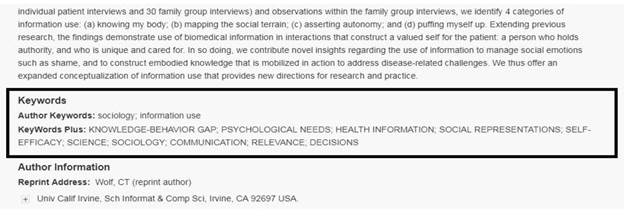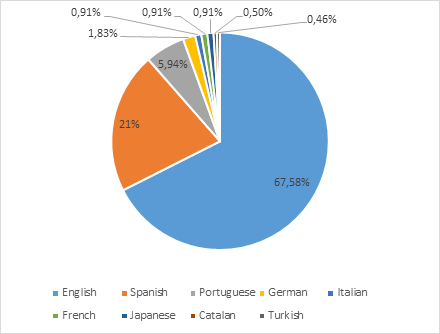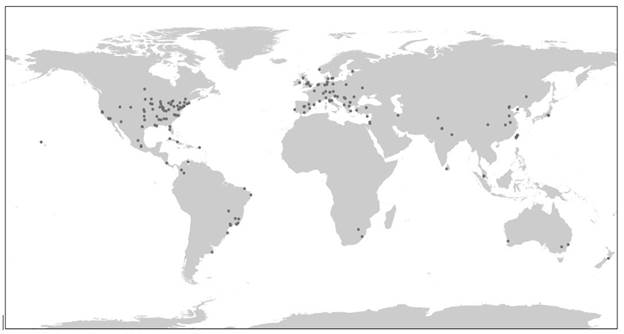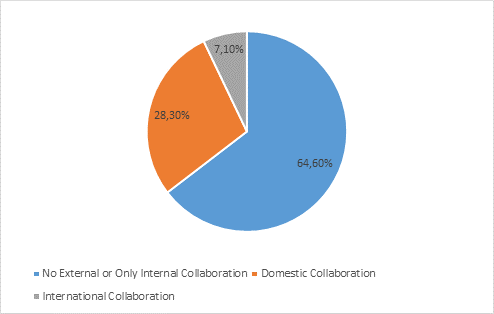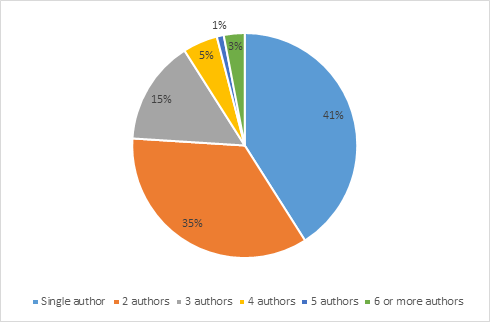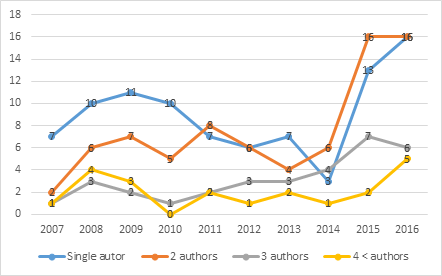Introduction
Research funders and promotion committees often require academics to show the relevance and impact of their work. Journal impact factor metrics have been used in the past to demonstrate influence on the field, but universities and funders are starting to ask for more practical collaborations and impacts of the research at local, national, and global levels (Cahill & Bazzacco, 2015; UNESCO, 2017). Considering this, ensuring worldwide access to and use of published research is becoming increasingly important for demonstrating research impact, ensuring wide readership, higher download/citation counts, creating interest in potential collaborations, and paving the way for funding opportunities. Thus, it is important for academic researchers to have their publications accessible in international aggregated databases. While internationalization of scholarly research is increasingly important for broadening researcher, institutional and disciplinary impact, there are also risks that have been identified as creating potential issues related to globalization, including “linguistic imperialism” (Phillipson, 1993), “cognitive capitalism” (Moulier-Boutang, 2012), “academic capitalism” (Slaughter & Rohades, 2010), and even “academic tribes and territories” (Becher & Trowler, 2001) which identify exclusivities inherent in language, geographic, political, economic and cultural divides.
At present, there are applied bibliometric studies to identify the scientific production in the area of Library Science and Information Sciences. Although there are some applied to specific countries such as Iran (Horris, 2004), the vast majority of current studies have focused on the measurement and / or comparison of scientific journals, such as the works of Vázquez, Ardanuy, López-Borrull and Ollé (2019), Lijina (2018) and Prieto-Gutiérrez and Segado-Boj (2019). Therefore, to date there have been no studies that reflect the development of Library and Information Sciences for a full decade.
Bibliometric methods have been widely used in LIS research for the analysis of literature and it is relevant to use it to update the bibliometric understanding of the recent international internationalization of library research as a means to discuss the impact and collaboration of international research. In this way, the purpose of this study is to examine and describe a decade of publications aggregated in the Web of Science database, considering there are no doubts regarding the importance and advantages of these database. Despite the emergence of important databases such as Scopus, Web of Science was a pioneer in bibliometric work and has more experience in the field. Until recently, it was the only international and multidisciplinary tool available for access to science, technology and other disciplines literature (Hernández-González, V., Sans-Rosell, N., Jové-Deltell, MC and Reverter-Masia, J., 2016). Having clear its advantages and also its disadvantages or disadvantages (such as Anglo-Saxon bias and information description problems), it is still configured as an important source of data.
The figures and tables we present here are intended to describe and analyse patterns of publication and collaboration in order to contribute to the understanding of research and publication in Library and Information Science (LIS).
We selected Web of Science (WOS) as the aggregate database for this study because of the “Information Science &Library Science” delimiting selection within that search interface, ensuring the collection search is focused on what WOS has indexed to be LIS literature. WOS uses author keywords identified by the authors of the specific article, and then WOS editors sometimes also review the works and “highlight additional relevant but overlooked keywords that were not listed by the author or publisher” (Sinha, 2010). These editor-provided keywords, called “KeyWords Plus,” are meant to ensure the retrieval of items using keywords that may change over time or have synonyms or closely related concepts. An example of this is shown in Figure 1 for the author keywords “sociology, information” which KeyWords Plus includes ten more identifying concepts like “health information” and “communication.”
Hence, this results in a more focused and relevant search in the database collection. We also chose WOS rather than Scopus because we use SCImago Journal Rankings for part of our analyses and we wanted to be sure we were not confounding our data when analysing journal ranking, as SCImago is a Scopus citation and journal rankings output.
Using the dataset retrieved with a search for “library science and information science” and filtering to include only the WOS indexed articles from 2007 to 2016, the questions that frame this study include:
What are the publication patterns of the documents about “library science” indexed in WOS during the 2007 to 2016 decade?
What is the range of languages of publication of the documents indexed in WOS between 2007 and 2016?
Which are the leading countries and institutions that produced the works indexed as “library science” between 2007 and 2016?
Which journals are indexed as representative of “library science” in WOS between 2007 and 2016?
What are the authorship patterns for “library science” publications indexed in WOS between 2007 and 2016?
Literature Review
Studies of bibliometric trends in LIS research are not uncommon in the library science literature, although we could not find previous works that explore LIS bibliometrics in the same way we do in this article. Studies have focused on topics such as an overview of LIS doctoral research (Barik & Jena, 2015), open access publishing (Ferreira & Neves, 2014), citation analyses of highly cited articles (Ivanović & Ho, 2016), productivity and research networks (Levitt & Thelwall, 2016), and research output and methods used (Chu, 2015; Hasan & Singh, 2015). Others have discussed thematic trends in the LIS literature such as Aharony’s (2012) review of articles from the top 10 LIS journals; Åström’s (2007) longitudinal analysis of changes in LIS research topic trends from 1990 to 2004; Chang and Huang’s (2012) and Dos Santos and Rodrigues’ (2014) bibliometric studies of interdisciplinarity in LIS published research; and Chang, Huang, and Lin’s (2015) look at the evolution of research subjects in LIS research from 1995 to 2014. Liberatore and Herrero-Solana (2013), Parada (2015a, 2015b), Ramirez (2016) and Da Silva (2013) offer additional international perspectives on trends and evolutions in LIS research based on their own bibliometric studies.
As our analyses include international perspectives on LIS bibliometrics, we note that a range of bibliometric studies are nation- or region-specific. For example, Echavarria et al. (2015) and Maz-Machado, Jimenez-Fanjul and Madrid (2015) highlight LIS research trends identified in bibliometric study of Iberoamerica and Caribbean literature and journals; Garg and Sharma (2017) and Mittal (2011) have explored Indian LIS bibliometric trends; Sugiuchi et al. (2011) have studied LIS research trends via bibliometric study of Japanese publications; Zhang (2014) provides longitudinal development of LIS research in China; and others have provided historical overviews of LIS research in other nations and areas of the world (e.g., Gauchi Risso, 2016; Gornstein & Peritz, 2013; Larivière, Sugimoto, & Cronin 2012; Nagarkar & Kumbhar, 2015; Tuomaala, Järvelin, & Vakkari, 2014). Han et al.’s (2014) study of international collaboration in LIS is of particular interest, as they provide historical data related to our analysis of networks observed in our own dataset.
Other, more general bibliometric studies of academic research and publication practices, including Collyer’s (2018) study of global academic publishing patterns, Endersby’s (1996) broad examination of authorship and publication credit in social science literature, and Godin and Gringas’ (2000) overview of academic impact, also add to the body of literature we have reviewed as we have worked to analyse and understand our dataset. Furthermore, reviewing historical bibliometric classics such as Lotka’s (1929) “law of bibliometrics”, which identifies statistical patterns of authorship and productivity, and Bradford’s law (1934), establishing the diminishing returns of citations, give us a deeper perspective in our analysis. We acknowledge the value of each of these previous bibliometric studies in providing literature that can help us capture globalized and longitudinal analyses of LIS bibliometric trends, and we will return to this body of literature later in this article as we report our own findings.
Method
Focus
The research is descriptive and is part of the positivist paradigm. It is a quantitative study that uses the techniques of Scientometric Analysis: Activity and impact metrics and first generation relational metrics.
Analysis unit
The corpus includes all documents published by topic “Library Science and Information Science”, in the Web of Science Core Collection database, Information Science & Library Science category, SCI-EXPANDED, SSCI, A & HCI, CPCI-S, CPCI-SSH indexes, BKCI-S, BKCI-SSH, ESCI.
The temporary coverage of the study corresponds to the period 2007-2016, and the recovery of the records was made on August 19, 2017 at the University of Playa Ancha.
Data collection and analysis processing
In this way, the sample was composed of 314 documents, collected by searching the WoS databases with the previously indicated keywords, which were exported to a database in MS Excel 2017, subsequently proceeding to the purification of records, mainly in relation to the standardization of authorships and institutional affiliation. After that, a systematic analysis of the tabulated metadata of the articles is carried out to generate the graphs and visually review the results of the analysis. Meanwhile, a complementary quantitative analysis was performed using R studio software (v. 1.1.423) to display a geographic map that shows the location of authors.
Analysis
We approached the data without preconceived ideas of what we might find, although we expected that the database might be somewhat skewed to favour North American journals and publications, as WOS was originally produced by the Canadian corporation Thomson Reuters and now is owned by United States company Clarivate Analytics. Still, as Clarivate Analytics operates in many countries and has a strong international presence, we deemed it a good aggregate database for discussion of our questions about international collaboration, authorship, and language. As our study is a joint effort among researchers at three universities in Australia, Chile, and the United States, we were ultimately interested in the nature of collaboration in the dataset and hope the following findings reflect our efforts to avoid bias and provide an inclusive international perspective in our analyses.
4.1 Results
Our findings are presented in order of the questions asked while we analysed the data, as they provide logical organization of the content and a good structure for our analyses. We have created graphs, tables and figures to represent the data in a manner intended to help the reader follow our discussion and analyses more easily and to add to a stronger understanding of the findings.
What are the publication patterns of the documents about “library science” indexed in WOS during the 2007 to 2016 decade?
Analysis of the 2007-2016 decade of research indexed as “library science” in the WOS database reveals divergent and expected trends in publications. In total, the 219 retrieved items classified by WOS as journal articles were included in the sample. 63 different journals were represented in this sample, including internationally-focused library science-oriented journals such as Information Research and Libri, but also including regionally focused journals such as African Journal of Library Archives and Information Science. Journals with five or more articles in our dataset are shown in Table 1.
Table 1 Journals Indexed in WOS, Ranked by Number of Articles Indexed
| Journal | No. of articles | % of 219 |
| Investigación Bibliotecológica | 31 | 14.16 |
| Scientometrics | 19 | 8.68 |
| Journal of the Association for Information Science and Technology | 9 | 4.11 |
| Library Trends | 8 | 3.65 |
| College & Research Libraries | 7 | 3.20 |
| Perspectivas em Ciência da Informação | 7 | 3.20 |
| Profesional de la Información | 7 | 3.20 |
| Informação & Sociedade | 6 | 2.74 |
| Library Quarterly | 6 | 2.74 |
| Journal of Academic Librarianship | 5 | 2.29 |
| Journal of the Medical Library Association | 5 | 2.29 |
| Malaysian Journal of Library and Information Science | 5 | 2.29 |
Source: Own elaboration, 2019
We were interested to see that the two journals with the highest number of LIS articles indexed in WOS were neither Canadian nor United States-based, but rather journals published in Mexico (Investigación Bibliotecológica) and the Netherlands (Scientometrics), with Brazil (Perspectivas em Ciência da Informação, Informação & Sociedade) and Spain (Profesional de la Información) also having a strong showing in the dataset. Other countries of publication include the United States (Journal of the Association for Information Science and Technology, Library Trends, College & Research Libraries, Library Quarterly, Journal of the Medical Library Association), the United Kingdom (Journal of Academic Librarianship) and Malaysia (Malaysian Journal of Library and Information Science).
What is the range of languages of publication of the documents indexed in WOS between 2007 and 2016?
Of the 219 journal articles, 148 articles, just over two thirds, were published in English. Spanish was the second most published language with 46 publications (21 percent). The pie graph in Figure 2 shows this visually. Together, English and Spanish make up almost 90 percent of the content represented in the 219 journal articles, and there is representation of indexing articles in journals published in other languages including Portuguese and German.
That Spanish language publications make up over 20 percent of the indexed publications retrieved from WOS with the “library science” search may indicate a positive step in access to non-English publications in the field, although citation counts still skew heavily toward English publications. In 2017, Olmeda-Gómez, Ovalle-Perandones and Perianes-Rodríguez reported that Spanish language articles and authors affiliated with Spanish institutions indexed in WOS rose significantly from 1984 to 2014 in the “Information Science and Library Science” category as WOS commenced indexing more Spanish language professional and research journals. However, they did not further limit their findings to “library science” specifically so no direct comparisons can be made with their findings. When we looked specifically at the journals indexed, we saw that all the journals indexed publish at least some articles in English, although quite a few of the journals publish in multiple languages. This is the case with Profesional de la Información (Spanish and English), Perspectivas em Ciência da Informação (Spanish, English, Portuguese and French), Investigación Bibliotecológica (Spanish, English and Portuguese), Informação & Sociedade (Spanish, English, Portuguese and occasionally French).
Half of the journals indexed were published by university presses, including Investigación Bibliotecológica (National Autonomous University of Mexico), Library Trends (Johns Hopkins University), Perspectivas em Ciência da Informação (Federal University of Minas Gerais), Informação & Sociedade (Federal University of Paraiba), Library Quarterly (University of Chicago) and Malaysian Journal of Library & Information Science (University of Malaysia).
Which are the leading countries and institutions that produced the works indexed as “library science” between 2007 and 2016?
Perhaps the most striking feature of the data are the countries and institutions of the 408 authors of the 219 journal articles, as shown in Table 2. The authors affiliate with 45 countries around the world and 205 institutions in total. The United States dominates the list with authors from 79 institutions. The next closest country to that figure is Brazil with authors at 14 institutions and Germany and Taiwan coming in next with 10 institutions each.
Table 2 Affiliate countries of the authors of the 219 Journal Articles
| Country | Number of Institutions | % of 219 |
|---|---|---|
| USA | 79 | 38.5 |
| Brazil | 14 | 6.8 |
| Germany | 10 | 4.8 |
| Taiwan | 10 | 4.8 |
| China | 8 | 3.9 |
| Spain | 7 | 3.4 |
| Bulgaria | 5 | 2.4 |
| England | 5 | 2.4 |
| Australia | 4 | 1.9 |
| India | 4 | 1.9 |
| Italy | 4 | 1.9 |
| Malaysia | 4 | 1.9 |
Source: Own elaboration, 2019
United States-affiliated researchers authored more than one-third of these “library science” articles. One reason for this is most likely due to there being more LIS researchers publishing in the United States than any other country worldwide (Jabeen, Yun, & Rafiq et al., 2015). Another reason is that WOS may have stronger alliances with American journal publishers since it is based in North America. However, LIS researchers from Australia do not typically limit their submissions to only Australian journals nor Swedish researchers only to European journals, etc., so even though WOS may possibly index more American-published journals, it does not follow that these journals necessarily contain more American content or articles written by Americans.
The map in Figure 3 presents the locations of authors, reflecting the dominance of northern hemisphere influence on these Library Science publications. This global north-south divide has been highlighted in other works overviewing global disparities in research and publishing (e.g., Jeffrey, 2014) so is not surprising. This map also shows how European countries, while perhaps not having more than three indexed “library science” publications per country in WOS, when mapped, show a reasonably even regional influence to that of the United States.
Which journals are indexed as representative of “library science” in WOS between 2007 and 2016?
The number of indexed articles per journal is related to the high periodicity of its journals. Most of the journals indexed are quarterly publications. Only Journal of the Association for Information Science and Technology (monthly) formerly known as the Journal of the American Society for Information Science and Technology, Journal of Academic Librarianship (bi-monthly) and College & Research Libraries (bi-monthly) are more frequent in publication schedules. The number of articles indexed in WOS per journal do not necessarily correlate with the SCImago Journal Rank (From now on and whenever mentioned, we shall refer to SJR as the abbreviated name of the indicator) or Quartile rankings. For example, the journal with the most indexed articles, Investigación Bibliotecológica, is ranked in the fourth quartile, with a 2016 SJR of 0.149, but has 31 articles in WOS, and an average of 0.68 citations, while the journal Scientometrics is in second listing, with 19 articles indexed, 7.26 average citations, and a 2016 SJR of 1.099, ranked in the first quartile. These figures are shown in Table 3.
Table 3 Journals with Highest Number of Indexed Articles (LIS) | Journal Impact Factor in 2016
| Journal | No. of articles in WOS | Average citations | 2016 SJR | 2016 Quartile |
| Investigación Bibliotecológica | 31 | 0.68 | 0.149 | Q4 |
| Scientometrics | 19 | 7.26 | 1.099 | Q1 |
| Journal of the Association for Information Science and Technology | 9 | 26.11 | 1.198 | Q1 |
| Library Trends | 8 | 2.71 | 0.357 | Q2 |
| College & Research Libraries | 7 | 6.57 | 1.938 | Q1 |
| Perspectivas em Ciência da Informação | 7 | 0.29 | 0.198 | Q3 |
| Profesional de la Información | 7 | 3.00 | 0.549 | Q1 |
| Informação & Sociedade | 6 | 0.67 | 0.152 | Q3 |
| Library Quarterly | 6 | 4.33 | 0.983 | Q1 |
| Journal of Academic Librarianship | 5 | 4.80 | 1.159 | Q1 |
| Journal of the Medical Library Association | 5 | 3.00 | 0.877 | Q1 |
| Malaysian Journal of Library and Information Science | 5 | 3.80 | 0.380 | Q2 |
Source: Own elaboration, 2019.
As WOS does not disclose specific criteria for their indexing practices, we can only guess that indexing decisions are based on factors such as topics covered, methods employed and/or a mission to provide balance in provision of content from various countries, regions, institutions, and in a range of languages.
While it can take five to twenty-five years to truly be able to map and measure research impact (Ebrahim, 2013; Penfield, Baker, & Scoble et al., 2013), in terms of the citations of the individual articles in our dataset, the numbers of citations per article indicated that 57 percent of the 219 journal articles had already been cited elsewhere within the ten-year period. These figures are shown in Figure 4. One 2011 article published in the Journal of the Association of Information Science and Technology was cited a total of 71 times while 42 percent of the sample had not yet been cited even once. In relation to this analysis, it is important to note that older articles have more time to be read and cited by the scientific community. For example, in 2016 47 articles were published, which have less dissemination time to achieve an increase in their citations.
These journal-level metrics seem to be reflective of Callaway’s (2016) warning that journal impact factors are deceptive. Callaway writes that most of the articles published in a given journal have lower citation rates than the journal in which they are published, as the journal citation rank is distorted by very few highly-cited articles. To add to this argument, our data also seem to indicate that journal impact factor does not necessarily predict number of articles indexed from in an aggregate research publication database such as WOS from a given journal.
What are the authorship patterns for “library science” publications indexed in WOS between 2007 and 2016?
In our review of authorship patterns, we particularly wanted to focus on the trend of co-authorship and collaboration that has been reportedly growing in the social sciences (Endersby, 1996). Research collaboration has also been linked to the maturity of a discipline or research system and the complexity of the scholarly networks reflects relationships between not only the authors but also their institutions and potentially their countries of affiliation (Ding, Rousseau, & Wolfram, 2014; Shin, Lee, & Kim, 2013). The pie graph in Figure 5 shows that most of the publications in our sample (64.6 percent) came from single institutions -- that is, the publication had only one author or, if more than one author, all are listed as being at the same institution (i.e., internal collaboration). Domestic collaborations of authors working with individuals at different institutions within the same country were the second highest count of collaborations on these publications, at 28.3 percent. International collaborations were a very small piece of this sample of publications with only 7 percent of the publications including authors collaborating from different countries in the world.
The small quantity of international collaborations is interesting in light of Han et al. (2014) review of international collaboration in LIS publications wherein they found international collaboration to have increased significantly from 2000 to 2011 and inferred that the trend would continue rising in following years. Factors such as geography, politics and language can affect international collaboration decisions and evidence of this seems to be seen in the choice of collaborators (Subramanyam, 1983).
That said, recent studies have shown that the number of papers written by two or more authors are increasingly outnumbering the number of articles written individually (Jeffery ,2014; Todeschini, & Baccini, 2016). In our dataset, we see that there is indeed a strong showing of collaborative publishing in the WOS library science articles. As Figure 6 shows, the authorship patterns of publications (including number of authors per article) in library science shows that single-authored papers still rank proportionately first: of the 219 journal articles in our study, 90 articles (41 percent) were written by a single author.
Additionally, it is important to note that the authorship trend throughout the decade indicated (Figure 7) shows a predominance of publications with a single author and two authors. The temporal evolution is relevant to understand how the predominance of production of articles with a single author is distributed over the years. Under this perspective, it is possible to affirm that the first five years have high predominance of individual research, while in the following years research in co-authorship becomes relevant.
Which authors are most indexed and cited and what are their most important contributions?
The ten authors with the highest number of publications in our dataset primarily affiliate with institutions in Europe and the United States, with two authors affiliating from institutions in Asia (China) or Latin America (Mexico). These authors are shown in Table 4 with their affiliations and rankings in our dataset.
Table 4 Authors Most Indexed in Dataset
| Rank | Author | Affiliation | Country | No. of Publications in Dataset |
|---|---|---|---|---|
| 1 | Thelwall, Mike | University of Wolverhampton | England | 7 |
| 2 | Tsay, Ming-Yueh | National Chengchi University | China | 6 |
| 3 | Levitt, Jonathan M. | University of Wolverhampton | England | 5 |
| 4 | Voutssas M, Juan | Universidad Nacional Autónoma de México | Mexico | 4 |
| 5 | Bornmann, Lutz | Max Planck Society | Germany | 3 |
| 6 | Leydesdorff, Loet | University of Amsterdam | Netherlands | 3 |
| 7 | Sugimoto, Cassidy R. | Indiana University | USA | 3 |
| 8 | Ni, Chaoqun | Indiana University | USA | 3 |
| 9 | Garoufallou, Emmanouel | Alexander Technological Educational Institute of Thessaloniki | Greece | 2 |
| 10 | Vassilakaki, Evgenia | Technological Educational Institute of Athens | Greece | 2 |
Source: Own elaboration, 2019
Of the twenty-six total publications written by these ten most-represented authors, nine of the papers were single-authored. All others were multiple-authored, with eight of these top ten authors collaborating in pairs with each other, including Thelwall and Levitt, Bornmann and Leydesdorff, Sugimoto and Ni, and Garoufallou and Vassilakaki. Three of these four collaborations are domestic in affiliation (Thelwall and Leavitt: England, Sugimoto and Ni: USA, and Garoufallou and Vassilakaki: Greece) and the fourth (Bornmann and Leydesdorff) is regional (Germany and Netherlands). Voutssas (Mexico) was the only scholar with all single-author publications; other authors collaborated with one or more author in their publications included in the dataset.
In terms of citation counts, the ten most-cited articles in our dataset are shown in Table 5. Nine were multi-authored articles and one was single-authored. Of the nine multi-authored publications, five were intra-institutional collaborations and four were international collaborations. This finding resonates with previous bibliometric studies such as Beaver (2004), Godin & Gingras (2000), and Hunter & Leahey (2008) which emphasize the increased epistemic authority, impact value, and institutional prestige associated with collaborative research.(See Appendix I)
[InsertarTable 5. Most Cited Articles and Type of Collaboration aqui]
While interdisciplinary collaborations hold unique challenges (e.g., different methodological approaches, communication, literature bases, foundational theoretical paradigms, value systems, language and terminology), the literature indicates that interdisciplinary collaboration is becoming increasingly important for success in academia, particularly for attaining grant funding (Gooch, 2005). This is an area that needs more study for the LIS field as the nature of the LIS discipline is ripe with opportunities for collaborations with other disciplines.
Conclusion
This broad-brush overview of LIS research publications collected in the WOS database is useful for researchers to see where we sit in terms of international research publications representing the field of “library and information science.” If researchers and practitioners using the WOS database are not accessing a global range of publications, this reduces the global impact and international exchange of ideas as well as potential for collaborations. Knowing who has access to read and respond to our research allows researchers to have a stronger position in research collaborations, inviting and influencing international research, particularly in countries with emerging research cultures like Latin America. This also can create a balance to the “academic capitalism” that can result from the majority of research publications coming from only a few select countries and cultures. These publications also share global perspectives in the field and diversify the international dialogue in terms of LIS. This research provides a baseline to chart future growth in LIS research publications because it can provide tools to directing the research to an interdisciplinary and collaborative way to the researchers.
On the other hand, the principal limitations of our analysis focus on methodological considerations and the structure of the WOS database. First, we only searched the WOS Core Collection which does not include the full suite of WOS databases available. We did this to try to ensure the findings might be replicable if done using the WOS database at a different institution. However, we do acknowledge that this search reflects a snapshot of one search on one day and it is possible that the same search done another day could reveal slightly different results as WOS indexers may be adding other materials as journals are added to the WOS collection. Furthermore, we are aware that using the keywords “library science” does not consider the interdisciplinary nature of the LIS field which is broad and wide-ranging in topic and focus. Many LIS researchers publish in a variety of journals and may not include “library science” as keywords for their research (or be so labelled by KeyWords PLUS indexers) if they are focusing on specific areas like school libraries, for example. Nonetheless, considering the importance put on impact factor, it becomes increasingly important for authors to mindfully choose the keywords they attach to their published research.
In addition, when reviewing author and institutional data, we searched institutional websites, Google Scholar, and Research Gate to try to gain additional understanding of who the authors were, their types of institutions and their disciplines. Based on our own experience in the field of Library and Information Science, we have made some inferences and deductions about author-discipline connections that we hope are correct but we could not prove or disprove with the data available to us without contacting the authors, which would have extended the study beyond our purpose of analysing the WOS dataset. Finally, there were some errors in WOS indexing, such as miswriting of names-primarily those of Latin origin-wherein two surnames are not uncommon and so when choosing which surname to omit or which comes first, at times WOS had variations on how author information was indexed. Many of these limitations are frequent in studies of this nature and can be considered not only as study limitations but also as improvement opportunities for indexing databases.
Finally, our study allows an overview of research in the field of LIS considering publication patterns, demographic data and information about authorship, which can be strengthened through new studies in areas of scientific collaboration, research networks and transdisciplinary areas to information science.














